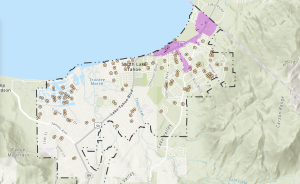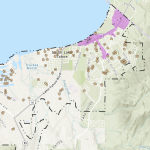Buffer removed from VHR ordinance, cannabis grants distributed total nearly $450,000
SOUTH LAKE TAHOE, Calif. – In an exceptionally long city council meeting on Tuesday, city council completed two items of unfinished business regarding the vacation home rental (VHR) ordinance and the cannabis grant program awards.
VHR ordinance
After a rocky start for some in the preferred program, the city opened the VHR permit applications to the general public. Many were dissatisfied with the outcome and voiced as much to council, and several people appealed their denied permits to the planning commission.
Of major concern during public comment was the 150-feet buffer. Several people found that they were buffered out during the first come, first serve system, which was confusing to them. Some mentioned that they paid substantial amounts of money to get their VHRs to compliance, only to miss out when their inspection was scheduled after someone else’s in the 150-feet buffer. Others said that parcel sizes in South Lake Tahoe could arbitrarily cause issues with the buffer, such as in areas like the Tahoe Keys where parcel boundaries extend into the waterways.
Police chief Jeff Roberson and city manager Joe Irvin said that they have not received any complaints to the VHR hotline.
Councilmember Scott Robbins was concerned about the planning commission’s decision to hear an appeal of what he felt was a cut and dry denial. “That is the planning commission deciding to substitute their judgement for ours.” Robbins, who has vocally been against VHRs, voiced further dissent to loosening the rules by making amendments to the ordinance.
Mayor Pro Tem Cody Bass said he supported figuring out how to amend the ordinance, but that it shouldn’t be amended too often, as they needed the time to collect meaningful data on how to amend it. He emphasized that these zoning decisions were to protect residential areas and that other areas of the city permitted having VHRs near each other. Bass felt that it would be wiser to make several amendments to the ordinance at once to prevent multiple delays to establishing the ordinance.
Bass also highlighted that Measure T was brought back to the appellate court, which could bring back the severability clause. “This could all go back the other way… and that is a really difficult position for us to be put in.”
Mayor Tamara Wallace suggested putting in a 25-year age restriction for renting and requiring online platforms to note when VHRs were in a residential zone. She and Robbins were interested in gathering better data on occupancy and would want to add room nights to the Transient Occupancy Tax (TOT) form.
City attorney Heather Stroud did note that there could be legal consequences for putting an age restriction, though she indicated she would do further research on the feasibility and what the city could potentially be liable for if they instated one.
Wallace also brought up the idea that they should remove the buffer and go back to the cap that was previously suggested. Councilmember David Jinkens also said that he was not in favor of the buffer either.
Councilmember Keith Roberts said that he was also against the buffer as it wasn’t generating the 1,200 cap of issued VHR permits. Robbins argued that because permitting was only opened to the general public recently, and that it was the intent of the buffer to slow the issuance of permits, that Roberts’ reason wasn’t sufficient to remove the buffer.
Wallace made a motion to:
- Remove the buffer and go to 1,200 cap or enable adjacent parcel owners
- Add a 25-year-old minimum age requirement
- Allow condos with homeowners’ associations to make their own rules
- Put family-friendly language on all platforms
- Room nights added to TOT form for VHRs
- Use hearing officer and an independent opinion on appeals for permits
- Handle residential properties and all others another way
- Refund fees to permit applicants who were buffered out and choose not to pursue a permit, except those fees to outside agencies
The motion was seconded by Jinkens. Robbins said sarcastically, “I love the fact that we’re going back to the way things used to be, so we can be surrounded on all sides by Bay Area party hounds.”
Wallace responded that the city previously had a policy of non-enforcement, which she attributed many of the issues with non-compliant VHRs to. Robbins retorted that it put the burden of enforcement back on residents and that the first enforcement action put forth to the city was ignored.
Robbins was the sole no vote on the motion, which passed.
Cannabis revenues grant program award
Sara Letton, city sustainability coordinator and facilitator of the cannabis revenues grant program, presented on the awards. City council policy states that up to half the previous year’s cannabis revenues received would be available for the 2025-2026 project year.
$400,000 was reserved for the program this year and staff recommended adding $46,415 to add to award 13 of the 22 applicants for the grant.
The 13 recommended groups were the Boys and Girls Club of Lake Tahoe, Christmas Cheer Inc., Clean Tahoe program, El Dorado Community Foundation Drug Store Project, Encompass Youth, Vista Rise Collective, South Tahoe High School Performing Arts Boosters Association, South Tahoe High School Sober Grad Night Task Force, South Tahoe Middle School Parent Teacher Association, Tahoe Alliance for Safe Kids, Tahoe Art League, Tahoe Coalition for the Homeless and Tahoe Youth and Family Services.
Attendees voiced their support of many of the organizations, but that the cannabis taxes were extremely high and that some of the previous awardees of the grant were not providing local services. One suggested that the dollars should stay local and help with in-city services, suggesting “Potheads for Potholes” as one concept.
Wallace noted that awardees like Gateway and Club Live were not on the list of recommended groups this year.
The motion passed unanimously, with Bass recused and abstaining from the vote due to his investment in the cannabis industry.
Further discussion on the cannabis tax rate, midtown area plan, emergency shelter and warm room along with other new business items continued after these items.
Eli Ramos is a reporter for Tahoe Daily Tribune. They are part of the 2024–26 cohort of California Local News Fellows through UC Berkeley.

Support Local Journalism

Support Local Journalism
Readers around the Lake Tahoe Basin and beyond make the Tahoe Tribune's work possible. Your financial contribution supports our efforts to deliver quality, locally relevant journalism.
Now more than ever, your support is critical to help us keep our community informed about the evolving coronavirus pandemic and the impact it is having locally. Every contribution, however large or small, will make a difference.
Your donation will help us continue to cover COVID-19 and our other vital local news.










